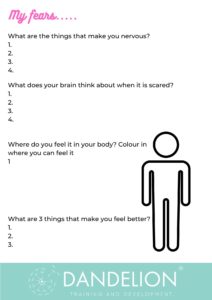Children’s Activities: Fears Worksheet
Fears and Worries
Fear is a primitive response, where the body reacts to potential threat of danger or risk of harm occurring. This can cause the sensation of anxiety, such as a rapid heart rate, nausea, shortness of breath, trembling, sweating. This may present itself as:
- Becoming angry or irritable over small things
- Bursting into tears for no known reason
- Being upset or tearful
- Difficulty relaxing – needing to be on the move
- Restless or agitated
- Frustrated when things do not go to plan
- Difficulty falling asleep or staying asleep
- Feeling numb or frozen
- Feeling anxious
- Worrying, questioning or uncertainty
- Lashing out at others
- Unable to stop their minds or ‘busy brain’
- Feeling tense – including headaches, jaw aches, grinding teeth and aches and pains
- Complaining of being exhausted or fatigued
- Difficulty concentrating
- Over reacting
- A sense of dread when having to approach a task
- A feeling that everything is ‘urgent’
- Flitting from task to task
- Being busy but achieving nothing
- Being self-critical
Sometimes, children can find it hard to identify the particular things causing them to be fearful or worried. Having sensitive conversations to help children to talk through fears and worries, as well as identify how they affect children can help them to understand the feelings, how they move and how to respond to it, supporting the development of emotional literacy:
- Recognise the emotion
- Label the emotion
- Respond to the emotion
Download (here)
How to use it?
- Download the worksheet here (download)
- Find a quiet space
- Take time to talk through each question
- Praise thoughts, feelings expressed and ideas
- Make a plan to move forward
You might want to look at our therapeutic stories to explore some of the feelings further (Find them here)
© Dandelion Training and Development – All Rights Reserved
Further help
 For more articles about mental health visit – ARTICLES
For more articles about mental health visit – ARTICLES
To learn more about child and adolescent mental health visit – COURSES
For resources to support child and adolescent mental health visit –RESOURCES

